| |
Patrol On Alert
Present-day artists typically entertain an
anxious, critical approach towards the world. And in times
of crisis they frequently revert to classical art in their
quest for a foothold and a dialogue with great Old Masters.
Classical art might occasionally appear to be a thing of the
past, while today’s artistic process is regarded as a mockery
of the former serious attitude. But is the method of profound
dialogue with the past really outdated? Whenever a format
- if the term is applicable to arts history – breaks down,
artists clearly tend to seek new forms and a new direction
of development. Such are the authors of a bronze remake of
Rembrandt’s picture: they boldly, yet carefully transposed
the masterpiece painting into sculpture.
Sculpture, the oldest and rather conservative
art, has now lost its impact, although its role in the urban
world is very important. It often tends to turn into something
unorthodox, mimicking and seemingly melting into a different
art. Undoubtedly, the striving to break out of the conventional
circle, to enter another dimension is inherent in contemporary
art. Nevertheless, Mikhail Dronov and Alexander Taratynov,
representatives of the realistic branch of modern plastic
art, do respect the boundaries laid down by the visceral nature
of their chosen art.
The two truly creative sculptors wished to
bring the famous painting by Rembrandt into contemporary context,
for they believe that the picture’s artistic potential allows
the use of various languages, including the cinematic one,
as was demonstrated by Peter Greenway. But, given the scale
of Rembrandt’s genius, how many would dare shoulder this responsibility?
So, A. Taratynov and Mikhail Dronov, both
members of the Russian Acdemy of Arts and top-ranking professionals
with vast artistic experience, invented a surprisingly effective
way of bringing Rembrandt’s characters to life. At the celebration
of the 400th anniversary of the Great Dutchman held in Holland
they displayed their bronze “Nightwatch 3D”, that had taken
them 5 years to execute. This interactive project started
back in 2001, long before the anniversary, and has since acquired
a few new characters, today numbering 22 figures. The bold
interpretation of the picture was on display in Maastricht
and the Hague, where it was officially unveiled by Queen Beatrix.
The installation is to be set up in Amsterdam,
near the museum of the great Dutchman. Perhaps, it was the
appearance of the multi-figure sculpture in Rembrandt Square
that triggered the Square’s restoration, for which the people
of Amsterdam had been campaigning for 30 years. Each of the
figures having a permanent pedestal, the picture characters
are ready to gain a new, unusual status: formerly actors of
a travelling “sculpture theatre”, they are turning into components
of a monument which is to surround the age-old statue of Rembrandt.
City authorities even dared to change the position of the
statue in space by turning it around, so that the bronze warriors
were lit to advantage. The chorus actors, though bronze ones,
step onto the stage, – actually, onto the city square, where
they are to sing a hymn not only on the evening of the performance,
but day after day. There is no denying that this role is far
from easy and requires extraordinary skill.
Holland greeted the monument by Taratynov
and Dronov enthusiastically when it arrived even before the
Rembrandt Year. Their unorthodox artistic idea allowed them
to give the well-known masterpiece a new life, for the sculpture
appears entitled to a world of its own. Obedient to the authors’
will, Rembrandt’s characters not only abandoned the canvas
plane to step out into three-dimensional space, they also
got their second wind. We won’t go into the educating role
of the plastic dramatization of the picture, which causes
even those who see the Master as a mere vintage addition to
glamour culture or a symbol of the ‘tulip country’, to change
their view. In fact, our optical perception does change after
we have really walked about inside the picture, thanks to
this 3D version of the “Nightwatch”. The square has become
a venue for Rembrandt’s characters, all slightly taller than
an average human. One can wander among the jaunty riflemen,
occasionally shaking hands with them (the warriors’ hands
and their halberds are already shining brightly, as if polished!).
Indeed, where else would you find not a mere copy or parody
of a picture, but its 3D reconstruction? Even the sketchily
painted figures were recreated down to the smallest detail.
The sculptors took the trouble to study historical works,
so as to reproduce faithfully the clothing and weaponry of
the time. But on taking a good look at the picture they realized
that the painter had depicted the foreground figures incredibly
thoroughly, literally forcing them to follow him in every
minutest detail. For facial likenesses, however, they relied
both on Rembrandt’s masterpiece and on handpicked real life
models, with the view to preserving stylistic unity… This
required total immersion in, and identification with, Rembrandt’s
work. At the same time the sculptors allowed themselves the
liberty of fantasizing a little: the Dutch still life is not
to be found on the original canvas.
In constructing the huge sculpture, the largest
in Holland today, Taratynov and Dronov were mindful of plastic
rules and spatial proportions as well as of the proper degree
of conventionality. The methods and materials - clay, bronze,
and manual casting – have been traditional for ages. The grandeur
of this neo-baroque piece, so full of movement, details and
typical theatricality, conveys with striking accuracy the
strong humanistic element characteristic of the Master. The
large number of figures and the immense size of the monument
– tons of metal and many cubic meters of space – do not cancel
its human scale. The viewers will certainly appreciate an
opportunity to feel like local militiamen, even though they
will subconsciously perceive the illusory effect of the composition.
The bronze “Nightwatch”, just like its pictorial forefather,
powerfully draws us into its expanse with the mighty movement
of diagonals, changing the onlookers into participants in
the event. By appropriating the old story and intensifying
tactile sensations, the sculptors transform it before our
eyes into a new art reality. This results in a breakthrough
into a different expanse, a kind of virtual fissure in history.
The opportunity to go round and look at the “underside” of
the familiar picture, surprisingly clothed in bronze, is almost
like a chance to see the hidden side of the Moon.
The art of Old Masters, on which the whole
project is based, is seen here as ever-living substance, inspiring
contemporary authors to produce uninhibited poetic statements
of their own. The position taken by M.Dronov and A. Taratynov
is far from timid, it is aggressive. Yet, their assault on
Rembrandt, clearly indicative of post-modernist aesthetic,
is devoid of derision and mockery, which is no surprise considering
the authors’ obvious respect for the classic art and their
consummate professionalism. The expressive plastic freedom
of the “Nightwatch” has one important aspect: the physical
touch of the creator’s hand, imprinted in the sculpture for
ever. There is nothing reactionary behind its realistic forms.
On the contrary, they are meant to pull down the walls of
academic art. Their healthy conservatism promoted the determined
search for a radically new format and a change of modus
operandi.
Basically, the remake of the picture, its
re-creation in sculpted form is actually nothing other than
a palimpsest, i.e. a text written over another text, a quasi-sacred
one in this case. The idea is far from new: classics also
used to converse with each other in a similar fashion, often
debunking long-established traditions. This takes us back
to the old debate that went on throughout the 20th century:
what is a great piece of art? A sacred object only to be reverentially
worshipped, or a guide to action? If it becomes a source of
popular quotes, it will rejoin the continuum of art history.
The sculptors have done a great job. The
giant bronze installation is a pure experiment based on personal
enthusiasm bordering on passion. Through it Dronov and Taratynov
make their creative work part of the new cultural paradigm,
which discards the dominance of the “flat picture”, so typical
of the art in the past. The fate of today’s art is to be spatial
and polysemous, as well as interactive: this is the only way
to breathe new life into an old piece. A. Taratynov and M.
Dronov do follow Rembrandt, though not in form, but in essence.
Having himself no liking for dogmatism, the Master was also
inclined to actualizing artistic work, and so has remained
an emblematic figure in art history.
2009
|
|
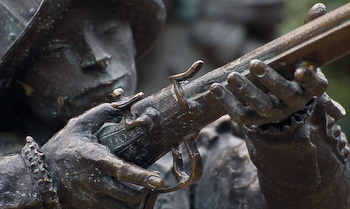
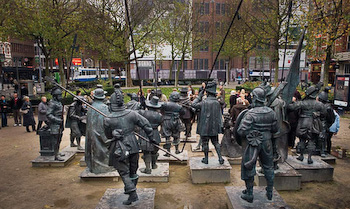
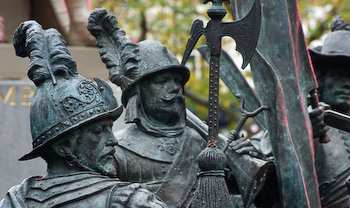
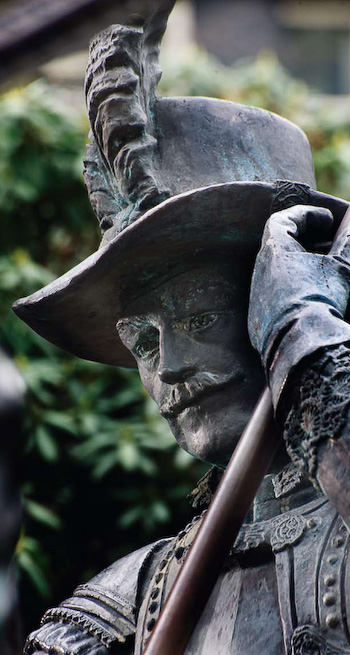
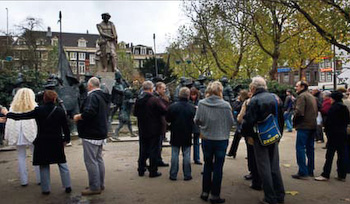
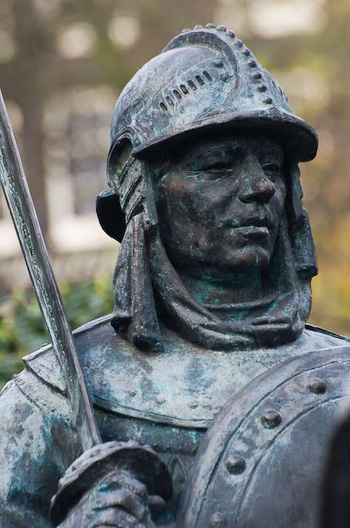
|